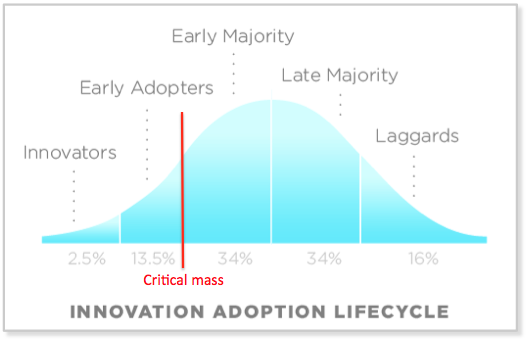
Wikipedia defines critical mass as the point when;
a sufficient number of adopters of an innovation in a social system so that the rate of adoption becomes self-sustaining and creates further growth.
When people will adopt depends on where they sit in the adoption lifecycle, and if you’re managing the implementation of a innovation into a company it’s crucial to help each group in their own adoption process. Critical mass is usually said to fall between the early adopters and the early majority, although some research puts it further into the early majority phase.

The five categories can be defined as:
- innovators – eager to try something new, need little training
- early adopters – quick to try something new, seek out new experiences, see benefits of the innovation
- early majority – open to new ideas, will try something if the purpose is clear, influence to colleagues
- late majority – want proof it works, safety and systems around anything they use,
- laggards – reluctant to change, sometimes only change because their existing tool is obsolete, or no longer available.
Not everyone is the same type for all innovations I’m an example of someone who can be an early adopter with one innovation and a laggard with another – I joined Linkedin in about 2005, but didn’t get a smart phone until last year.
Critical mass, where the growth in adoption becomes self sustaining, is reached when the early majority start to take up your innovation.
I’m trying to apply this to our implementation of an Enterprise Social Network, we have a total target audience of about 65,000 and so far 45,000 have signed up to use the tool. So that sounds like we’re already into the late majority – job done.
Except signing up is a low impact activity and doesn’t reflect a real use. It just means the person has agreed to the terms and conditions.
So I’ve been looking for some other measurable behaviours which we could consider as a threshold for use.
We see a monthly report on active users. To be considered an active user you need to have done something – anything – in the time frame measured. The activity could be five useful answers to five other users or it could be a comment or a like. So it’s a very broad measure, but by this measure we are into the early majority as of January – just.
We have implemented badges on our enterprise social network and this might give the best measure of where we are on the adoption lifecycle. The lowest level badge, the “starter” badge rewards a low level of activity; a post and a few comments and you’re there. By this measure we’re about to enter the “early adopters” stage. However badges were only introduced 6 months after launch so they under measure the adoption activity.
Looking at all these measures, the data per country, and reviewing how the Enterprise Social Network is used I believe we’re still with the early adopters across the company, but we’re into the early majority in the two countries with the largest numbers of employees. This is huge progress. Now the challenge is to embed this Enterprise Social Network in the company, my real measure of success is when it’s just how we work.
Images boulder
Work found at http://en.wikipedia.org/wiki/File:DiffusionOfInnovation.png / CC BY-SA 3.0